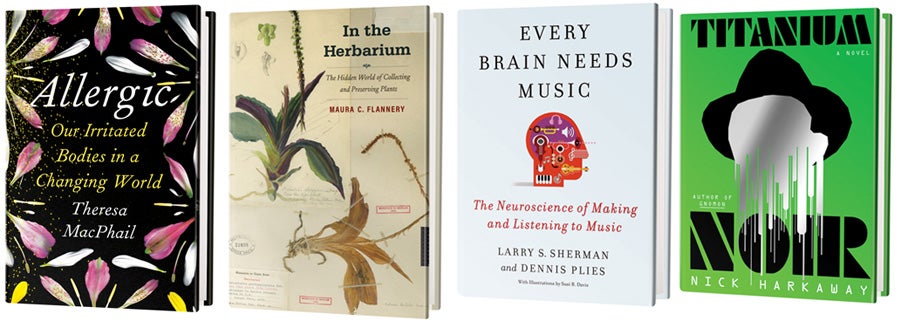Allergic: Our Irritated Bodies in a Changing World
by Theresa MacPhail
Random House, 2023 ($28.99)
Decades after her father's terrifying death from a bee sting, Theresa MacPhail learned that she, too, had allergies. The surprising diagnosis came after she contracted four respiratory infections in less than a year and made visits to specialists. What caused the seemingly sudden onset of her allergies?
Unimpressed by the books she found in her search for answers, MacPhail, a medical anthropologist, began writing Allergic as a “personal and scientific journey to diagnose the problem of allergy in the twenty-first century.” The result is a meticulous study of respiratory, food and skin allergies in three parts—diagnosis, theory and treatment—told through patients' stories and expert interviews.
The book begins in doctors' offices, where frustrations abound. People may itch, cough and wheeze in response to allergens without showing an important diagnostic sign of an allergic response: heightened levels of immunoglobulin E antibodies. Others may have positive antibody tests but suffer no other clinical symptoms. Researchers are working on better tests, but MacPhail is focused mainly on the problem of health-care inaccessibility. Even when improved technologies arrive, she says, it is likely that only a few will benefit from them.
When MacPhail shifts from the personal to the global, ambiguity remains. What is driving the troubling upward trend in allergy prevalence worldwide? Perhaps it's because climate change is lengthening pollen seasons, or maybe our modern hygiene habits are removing beneficial microbes from our skin and increasing its permeability. Each theory has its merits and shortfalls, and in combination, they might explain our growing sensitivities.
Treatments come with their own challenges and personal assessments. For a peanut-sensitive child, months of oral immunotherapy starting with very low doses are vital to prevent anaphylaxis, whereas for a man with eczema, instant relief from immune-enzyme-modulating JAK inhibitors may be worth the long-term risk of heart disease. Yet clinical interventions alone won't be enough to control the allergy epidemic fueled by our changing environments. That requires policies that phase out fossil fuels, improve air quality and fund more allergy research into underlying causes.
MacPhail makes the argument that as scientists continue to disentangle the biological complexities of allergies, we also need societal shifts to soothe our increasingly irritated world. —Fionna M. D. Samuels
In Brief
Titanium Noir
by Nick Harkaway
Knopf, 2023 ($28)
Sharp as a shiv but wickedly playful, Nick Harkaway's near-future noir sends Cal Sounder, an all too human detective, into the realm of literal giants. This future's richest people can indulge in titanium 7 rejuvenation therapy, which “turns the body's clock back” to restart puberty, making adults young again—and, with each new dose, increasingly huge. The apparent murder of a titan sets Sounder on a classic hard-boiled mystery case, with a detective's-eye view of the lowest and highest echelons of a fascinating city, plus rigorously imagined speculative genetic science and its consequences. Harkaway's trademarks abound: brisk dialogue, wild set pieces and dead-serious considerations of humanity's next evolution. —Alan Scherstuhl
In Herbarium: The Hidden World of Collecting and Preserving Plants
by Maura C. Flannery
Yale University Press, 2023 ($35)
Historically, herbaria—collections of dried, pressed and labeled plants—have been tied to political and economic power. They played key roles in scientific achievements such as Carl Linnaeus's development of binomial nomenclature and Charles Darwin's theory of evolution. Biologist Maura C. Flannery makes a compelling case for reinvigorating the relevance of these “hidden gardens” by exploring their significance as bellwethers of climate change, libraries for biodiversity research, sources of plant DNA, and opportunities to acknowledge and amend the erasure of Indigenous and enslaved people's contributions to botany. —Dana Dunham
Every Brain Needs Music: The Neuroscience of Making and Listening to Music
by Larry S. Sherman and Dennis Plies
Columbia University Press, 2023 ($32)
In the 17 years since the popular book This Is Your Brain on Music was published, functional MRI has allowed scientists to visualize how music shapes the brain during composition, performance and listening. Now a neuroscientist, Larry S. Sherman, and a professional musician, Dennis Plies, have collaborated on their own version, which puts academic analysis in conversation with feedback from dozens of composers and musicians. Music, the authors write, creates cells in the brain that act like disco balls in a space full of lamps: it “turns your living room into a party every time.” —Maddie Bender


